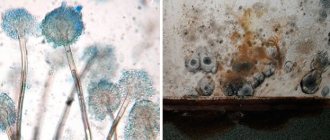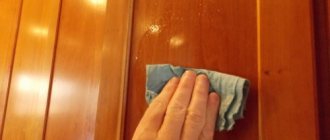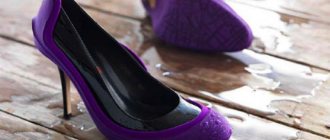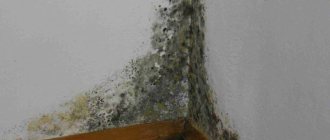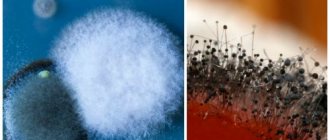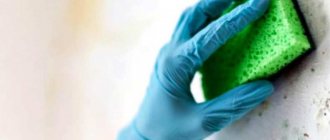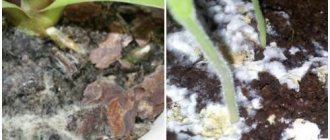Mold can be found in absolutely all rooms. The fungus can be on walls, floors or cabinets, as well as in food. However, most often it can be found in the cellar. Why does this happen and how to get rid of the fungus? We will try to sort out such questions in this article.
The appearance of mold in the cellar is a common problem, and it no longer surprises anyone. The occurrence of fungus in the cellar is due to several reasons that need to be identified and removed. Without eliminating the root causes, it will not be possible to destroy the fungus, but only remove mold for a short period of time using various antifungal agents.
- Poorly insulated walls
- moldy
How to get rid of fungus in the cellar
Having established the cause of the fungus and its variety, it is worth finding out how to fight it. Today, there are 3 effective methods that can be used to successfully remove mold from all contaminated premises. However, in addition to folk remedies and techniques, there are special chemicals for complete elimination.
Note: Most of the known techniques are based on major repairs of the premises and are needed in case of a neglected situation. However, in case of partial contamination of the premises, disinfectants can be used for preventive purposes.
A solution consisting of 10 liters of water and 250 ml of 40% formaldehyde is very popular. The surfaces must be treated with the solution, and after complete drying, the walls and ceiling must be plastered and whitewashed. The success of preventative treatment is based on the good functioning of the ventilation system.
Sulfur checker
A sulfur bomb is one of the old and proven methods that will help get rid of fungus in the house under the floor. However, it is worth clarifying about this method that during its operation you need to leave the living space for several days. The implementation of this procedure is not considered difficult.
Note: You need to start by calculating the volume of the underground or cellar area, since the packs with the sulfur bomb indicate parameters for use in rooms of different sizes.
After establishing the required proportion of the sulfur bomb, it is lit and left in a smoking state at the bottom of a metal container or glass jar (Figure 1). The bomb should smoke for several hours and during this time the whole room will be in smoke, but the smell will then quickly disappear.
Figure 1. Processing the storage facility with a sulfur bomb
The result of the action of the sulfur bomb is temporary or complete removal of the fungus. You can buy a sulfur bomb at any gardening store.
Lime
The use of disinfection in the basement or cellar will help get rid of the fungus and prepare for further work that will be aimed at improving ventilation and waterproofing.
All manipulations in the room must begin with clearing it of racks, cans and other things. Use a wire brush to clean all walls, paying special attention to areas where mold has occurred. The racks must be dried in fresh air and treated with disinfectants (Figure 2).
If there is a dirt floor in the cellar, you need to remove the top layer of soil and disinfect it with a sulfur bomb.
Figure 2. Using lime to treat underground storage facilities
The main feature of sulfur gas is its ability to penetrate into the most inaccessible places. However, before using a sulfur bomb, you should close all ventilation holes so that the gas does not leave the room. Upon completion of the procedure, it is necessary to ventilate the room for 10 hours, after which the ceiling and walls in the cellar can be treated with slaked lime.
Bleaching
Today, chlorine is included in the composition of a large number of detergents, disinfectants and bleaches. One of the common products that contain chlorine is “Whiteness,” but at the same time, you can use any other detergent product with an active component of bleach.
The preparation of a highly concentrated chlorine solution is based on one bucket, but when working with this kind of chemical, it is imperative to follow safety precautions and wear gloves. Treating walls with chlorine solution must be done very carefully, paying special attention to the ceiling and other places where fungus appears.
Boric acid
In the fight against mold, you can use some traditional methods to effectively and quickly destroy the fungus. Mix water, copper sulfate and acetic acid in a ratio of 20:1:4, then mix thoroughly and begin surface treatment.
Hot and cold fog generators
This is the most innovative method to eliminate fungus in the basement. It is carried out using special aerosol generators. Before processing, it is necessary to remove all existing food and animal feed (including from the refrigerator).
Fumigation occurs without preliminary preparation, not counting the general calculation of the aerosol or solution required for processing.
The principle of operation of aerosol devices for fumigation is the local distribution of the prepared mixture, which, depending on the type of equipment. The substance turns into steam or is sprayed under high pressure.
Such disinfection should only be carried out by trained specialists. Their devices have a much greater impact on infection, and the work experience gained allows them to avoid negative effects on human health.
What causes fungus to form?
Since ancient times, the cellar and basement have been places intended for storing food supplies. Cold and moisture contribute to a long shelf life of stocks, but at the same time they are excellent conditions for the rapid development and growth of fungi.
The main reasons for the appearance of mold in the cellar are the following factors:
- High temperature level (more than +20);
- Constant humidity above 90%;
- Poor seam insulation;
- High level of residual moisture of materials used in construction;
- Lack or poor waterproofing.
Preventive measures and the fight against fungus should be aimed at installing a high-quality ventilation system and waterproofing of the room.
Poorly insulated walls
Mold is an organism that can live on all surfaces. Its spores are incredibly small and surround a person everywhere, since they are invisible to the human eye. When the spores find a suitable place for their growth, they settle there and begin to actively develop. During the settling of spores in a favorable place, the formation of mycelium occurs, which penetrates deep into the materials and begins to form new spores.
Figure 3. Scheme of external insulation of an underground storage facility
The cellar can be considered the most ideal place for fungus to multiply and this is explained by the following reasons:
- There is poor air flow into the room and there is no oxygen circulation.
- High humidity levels contribute to the formation of condensation on the walls, which cannot evaporate.
- In cellars there are always many sources for feeding fungi (food, wood, concrete), which contribute to the further spread of mold throughout the room.
Figure 3 shows how to properly insulate to prevent mold from appearing in an underground storage facility.
Violation of temperature and humidity conditions
The main reasons for the appearance of mold in the cellar are poor air ventilation and waterproofing, condensation and prolonged storage of spoiled products, as well as the use of shelves made of mold-infected wood.
However, it is customary to identify the following main causes of mold:
- Moisture entering the cellar by capillary action through the walls.
- Water leakage through cracks in walls (structures).
- The presence of poor ventilation, which contributes to the formation of condensation on the walls of the room.
The first signs of mold can be observed when drops of water appear on the walls and structures in the room, in musty and stale air. To combat mold, you should establish a ventilation system and eliminate all sources of water entering the cellar or basement. With these actions, you can establish the air exchange system in the room and the humidity level will return to normal. After bringing the ventilation system back to normal, all that remains is to remove the resulting fungus from the walls.
Floors are not insulated enough
It is possible to get rid of mold in the cellar forever, but to do this it is necessary to eliminate not only visible accumulations, but also to create conditions in which the growth of mold and its existence will be impossible.
Important points:
- Ensuring stable air circulation involves regular ventilation (15-20 minutes per day) and the installation of a comprehensive ventilation system. To ensure air circulation, you can make a hole in the door and leave free space under the door. You can also remove two pipes from the cellar (from the ceiling and from the floor), which will allow oxygen to flow throughout the day and prevent the growth of mold.
- Waterproof the cellar: the complex of waterproofing work includes sealing cracks that can allow moisture to enter the cellar. However, it is impossible to do without covering the walls and floors with moisture-proof materials.
- Reducing the level of air humidity in the cellar. To combat air humidity, you can use heaters or periodically place heated ceramic bricks around the perimeter of the cellar. Reduce air humidity with white moss or containers of slaked lime.
The main conditions for the appearance of mold
In practice, they often face the problem of sudden rotting of vegetables and the appearance of mold on cans of canned food, and they notice this mainly in winter. The fact is that for the good development of mold spores, two conditions are necessary: high humidity and a temperature above five degrees. As a rule, due to poor air ventilation and damaged waterproofing, the humidity in the cellars is increased, which means there is a danger of fungus. Many who face this problem eventually stop paying attention to it, but in vain, because mold can have a detrimental effect on the human body (its spores enter the lungs or skin and can cause allergies, headaches or even asthma). It would seem that, due to the fact that we rarely go down to the cellar, the danger of inhaling harmful fungal spores is small, however, this is not the case. In addition, mold can move from walls and ceilings to stored vegetables and other products, which not only reduces their shelf life, but also poses a more obvious threat to health. The fungus spoils not only food, its harmful influence also extends to walls and wooden structures (from mold they begin to rot) located in the cellar. Considering the speed with which the fungus spreads in conditions that are comfortable for it, we can conclude that the cellar needs to be treated against the pest as soon as possible.
Types of fungus and methods for detecting it
The fungus is one of the most ancient organisms on the planet and its main feature is the ability to absorb the substances it needs from the environment (Figure 4). During the processing of absorbed substances, it releases toxins, carbon dioxide and esters, which are responsible for the peculiar and unique smell of mold.
moldy
The appearance of mold organisms usually occurs on stone or concrete, as well as on all surfaces treated with poor quality paint. This type of mold has spots of black, blue, green or brown color. Mold fungus is capable of destroying materials and can completely destroy the finish, which leads to a complete renovation of the room.
Blue
Blue fungus is the most important danger for wooden houses. When a tree is damaged, spores penetrate into the structure of the tree, after which it changes color to a blue tint.
However, in addition to external changes in the tree, its humidity level increases. With constant penetration of moisture, new types of fungus will appear in the wood.
Rotting fungus
Only wooden surfaces are susceptible to decay fungi, and the microorganisms themselves come in several types. When a tree is damaged by bacterial rot, the color changes to a gray tint and the strength of the material is lost.
Figure 4. Main types of fungus (from left to right): mold, blue, rot
Brown rot can cause even the strongest wood to split in a short period of time. However, we should not forget about white mold, which is the most dangerous for wood, which is known to quickly damage the material and make it unusable. White fungus also tends to spread to neighboring rooms.
Purchased funds
Store-bought formulations effectively get rid of the problem and work as further prevention. The most popular of them:
- ArmMix Biocide gel . Suitable for processing stone and concrete premises.
- Olimp stop mold . It copes well with fungus, but is absolutely safe for animals and humans.
- Antifungal . Suitable for use on any materials.
- Spectrum Fungicide . Effective on wooden surfaces, concrete and metal, as well as other materials.
- Atlas Mykos . Suitable for use on any surface. Does not leave stains.
- Sulfur checker . Sulfur vapor allows you to clean the cellar of mold and mildew using a non-contact method. You just need to take all the food out of the basement, and then put a special bomb on the floor and set it on fire.
- Dezaktin . A popular means for disinfecting various products. To eliminate mold in the cellar, the drug is diluted following the instructions and the room is treated.
What methods do you use to fight mold? Folk remedies have proven themselves to be effective, budget-friendly and effective.
100%
I buy whatever is available at the store. I like it and there is no mold.
0%
I combine methods, I think this is the most effective option.
0%
Voted: 1
Get rid of fungus in the cellar with your own hands
The fight against fungus in a cellar or basement should be comprehensive and consist of several stages.
Preparing the room should include the following steps:
- The cellar must be emptied during the mold removal operation. In an empty room it is easier to reach any surface and possible habitats of microorganisms. Completely emptying the cellar will help protect the food stored in it from mold.
- Shelving, furniture and other items must be taken out into the fresh air, as they will need to be inspected and cleaned.
- Carrying out general cleaning in the cellar allows you to remove all accumulations of fungus. Also, if infected wooden structures are found, they need to be replaced with new ones.
- If there is an earthen floor in the cellar, it is necessary to remove the top layer (10-20 cm), since it may be affected by mold.
- Upon completion of cleaning, the room should be dry and it will be possible to begin further struggle.
Removing mold from the cellar is not easy, since it must be destroyed and exterminated. In domestic hardware stores you can purchase special antiseptics that have antifungal and antibacterial effects. The use of this kind of specialized products must be carried out strictly according to the instructions specified in them.
You can use the following folk methods of struggle:
- Treat the affected surfaces with white (it contains components that destroy mold);
- Use ammonia;
- An effective remedy is citric acid, but it must be used in concentrated form. Citric acid (100 grams) is added to one liter of water and mixed thoroughly;
- For 30-40 liters of water, you need to add 2 kg of quicklime and about 300 grams of copper sulfate. The resulting solution must be used to treat all surfaces in the cellar or basement (walls, ceiling and floor);
- The use of sulfur bombs is a time-tested remedy that helps get rid of various pests;
- For 5 liters of boiling water you need to dissolve about 1 kilogram of salt and 100 ml of boric acid;
- Dissolve 50-100 grams of bleach and slaked lime in one liter of water;
- The fungus does not tolerate elevated temperatures and can simply be burned with a burner, while treating all surfaces. However, it is not recommended to process wood using this method;
- You can prepare a solution of formaldehyde and bleach by dissolving 50 grams of each component in 2 liters of water.
Figure 5. Effective methods of combating mold
After treating the surfaces in the cellar with one of the listed compounds, you need to leave the room and ventilate the room after the product has completed its effect (Figure 5). However, the fight against fungus does not end there and it is worth creating conditions in which mold cannot reproduce and exist.
Important points:
- Providing air circulation. Try to ventilate the cellar as often as possible and carry out this procedure at least once a day for 15-20 minutes. It is also necessary to equip a ventilation system. The simplest option is to make several holes in the door and provide free space under the door, and you can also install two pipes in the ceiling and take them out of the room (one from the floor, the other from the ceiling), which guarantees constant air circulation and will prevent the growth of fungus . Also in the cellar it is necessary to move all objects away from the walls, which will stop the formation of condensation.
- Providing waterproofing. In the system for eliminating problems with water entering the cellar, the first priority is to seal all cracks. After this, a waterproofing layer is installed using a coating of moisture-proof material (floor, ceiling and walls).
- Reducing air humidity levels. To reduce humidity in the cellar, you can use a heater or periodically place heated ceramic bricks around the perimeter of the room, which absorb moisture well.
White moss or containers with quicklime placed in the corners of the room also perfectly absorb liquid. However, to avoid an increase in air humidity, it is necessary to tightly close all open containers with liquid composition.
Effective methods of control
As mentioned earlier, immediately after identifying foci of infection, you need to move on to its immediate elimination. This needs to be approached comprehensively, focusing on the main reason for the formation of flowers. For example, if it appears due to problems with the sewage system, and you are struggling with high humidity, then after a while you will again have to spend money and effort to combat the spread of spores.
Treating a basement for mold is a set of measures consisting of several sequential actions. Below, we will describe some practical tips on how to remove fungus:
- During processing, food, objects, and any equipment should be removed from the cellar. As a result, previously closed areas will be accessible, which will improve the overall quality of disinfection.
- Shelving, furniture, and things removed from the premises will need to be processed and dried properly. This will get rid of the remains of rotten rot and avoid re-infection.
- Carry out a general cleaning, removing any defective formations. If the spores have penetrated deep into the finishing material or wooden base, it will need to be completely replaced. Infected surfaces are best burned.
- After the cleaning is completed, it’s time to dry the cellar.
This ends only the first stage of cleaning. Now you need to choose several means that can destroy the spores. Next, effective ways to remove rot will be given.
Harm to human health
The fungus tends to spread quickly, and the fact that indoor surfaces are contaminated is a minor problem when compared with the threat to human health. Mold spores can enter the human body through the respiratory tract and settle in the lungs, and can also be ingested through skin, hygiene items and food. For this reason, mold control is an important hygiene measure. Some types of fungus cause asthma, headaches, dry cough and skin rashes.
During its life in the basement, the fungus actively releases harmful toxins in the form of numerous spores that are dangerous to humans.
Doctors associate prolonged contact with such substances with the occurrence of such diseases:
- Migraine;
- Chronic respiratory diseases;
- Increased irritability;
- Allergies.
Mold is believed to be dangerous for young children because their respiratory systems are not fully developed. Children exposed to fungi may be at risk of developing chronic respiratory diseases and allergies. The danger of mold spores is explained by their invisibility to the human eye. In the first stages, mold development does not look scary. However, discoloration of the walls in the cellar, black formations on the ceiling and peeling of the walls require emergency intervention.
Vacuum cleaner
Regularly cleaning your basement with a HEPA (High efficiency particulate air) vacuum cleaner helps reduce the development of allergic reactions that occur due to toxins released by spores and also reduces the amount of mold.
When you vacuum with a regular vacuum cleaner, most of the spores pass through the filtration process and are released back into the air. This happens because they are too small for regular filters.
But when you vacuum with HEPA, the spores are caught in the filter and remain inside.
In addition to reducing mildew, this vacuum also removes other types of allergens.
This procedure should be carried out throughout the house, not just in the basement, at least once a week to minimize mold.
Preventing basement from fungus
In order to maintain the cellar in proper condition, it is necessary to carry out preventive maintenance every year to prevent the development of fungus. To do this, the cellar must be completely cleaned (general cleaning), and then the room must be thoroughly dried. Drying time depends on the condition of the room and lasts from several days to several weeks.
Note: Shelves and crossbars should be treated with soapy water and placed in the sun. Once the boards have dried, they must be treated with an antifungal solution.
The dried cellar should be treated with an antifungal solution and antibacterial agents, after which additional drying of the room is carried out.
If the cellar has an earthen floor, then you need to pour a solution of copper sulfate onto it and let it soak into the soil. And in places where vegetables are stored, it is necessary to pour a mixture of sand and lime.
Precautionary measures
Since most anti-mold products are quite dangerous if handled carelessly, basement treatment is carried out using personal protective equipment. To do this, before starting work, put on rubber gloves, a respirator or mask, and safety glasses. Exposed parts of the body are protected with a special suit.
Solutions prepared for treatment should not be touched or inhaled. After the antifungal solution is applied to the walls and other surfaces, the room must be left and the entrance closed for several hours.
Important! Do not eat foods contaminated with mold. They will definitely be thrown out.
